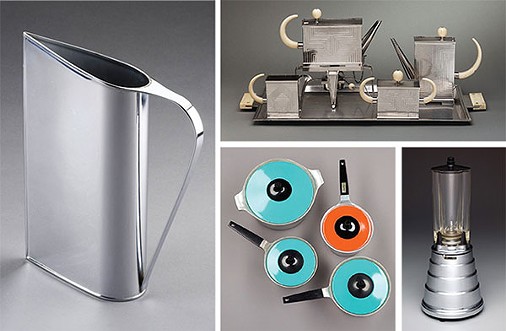What would John Ruskin and William Morris have made of Peter Muller-Munk? If they had seen Silver to Steel: The Modern Designs of Peter Muller-Munk, at the Carnegie Museum of Art, maybe they would have thrown in the towel and embraced the marriage of craftsmanship and industrial production.
Then again, there is plenty of evidence that mass production can churn out oodles of crap. But beautiful handmade things often come with a hefty price. And while there is no shortage of reasonably priced items with celebrity designer names attached to them at big-box stores, these things are often made with poor materials in overseas factories with questionable labor practices, and the pieces rarely hold up over time.
Industrial design is linked to the rise of mechanization, urbanization, a growing middle class and a shift in patterns of consumption. According to Silver to Steel exhibition materials, Muller-Munk was one of the preeminent industrial designers of the mid-20th century and he inspired a revolution by recognizing a growing middle-class demand for beautiful and functional everyday items in the post-World War II era.
Muller-Munk was raised in Berlin, Germany. Around 1923, his mother met the sculptor and silversmith Waldemar Raemisch, and this led to a fortuitous apprenticeship for her son, who had decided that he wanted to work with his hands. Raemisch was a professor at the Unified State Schools for Fine and Applied Art. The school was born out of a merger between two schools in Berlin. Its direction was set by Bruno Paul, who believed in the ideals of the Arts and Crafts Movement combined with the practicality of machine production with an eye toward modernism and the avant-garde.

These early influences are evident throughout Muller-Munk’s work. The exhibition — the first retrospective dedicated to his life’s work — is organized in a more or less chronological fashion. It begins with his elegant and stunning hand-wrought silver pieces from the 1920s and ’30s. In 1926, Muller-Munk moved to New York and worked for almost two years at the bench of Tiffany & Co. before opening his own studio. He quickly gained a reputation, but as the demand for luxury goods declined due to the Great Depression, he grew dissatisfied with the “exclusivity of handmade work.”
In 1935, in an effort to do something different, Muller-Munk combined traditional silver methods with affordable materials to make one of his most famous creations, the Normandie pitcher. Based on the shape of the luxury ship the SS Normandie, this shiny, streamlined tabletop pitcher was distinctively modern. Interested in a broader application to make useful things in larger quantities, he envisioned a role for industrial design in mass production while adapting modern designs to suit industrial processes. By using electroplating and chrome, he created affordable high-styled tableware and personal accessories.
It was also in 1935 that Muller-Monk moved to Pittsburgh to teach as an assistant professor of industrial design in a newly formed program at the Carnegie Institute of Technology. Within the next few years, he also created his design-consultancy firm, Peter Muller-Munk Associates (PMMA), which would become one of the top 10 in the nation. The major local industries of steel, aluminum and glass would greatly influence his creative energy, along with other modern industrial materials, such as plastic.
PMMA worked on appliances, graphic design and technical literature. The exhibition offers a dizzying array of mass-produced products including cameras, lighters, mirrors, brushes, clocks, hearing aids, refrigerators, freezers, power tools, safety helmets and even a gasoline pump. Of note is the Waring blender, redesigned by Muller-Munk with such aesthetic appeal that it has become iconic. Also eye-catching at the Carnegie is the wall of Bissell vacuums and sweepers, displayed against bright stripes of paint as if at a product trade show. For Bissell, PMMA delivered a “total corporate service,” not only consulting on product design, but also creating the company’s entire corporate identity, packaging, displays and even the design of their executive offices.
Good design is now a mainstay of our everyday life, and the democratization of design means that product development should be visually striking, user-friendly and functional. And this is exactly what the co-organizers of this exhibition — Rachel Delphia, The Alan G. and Jane A. Lehman Curator of Decorative Arts and Design at Carnegie, and Jewel Stern, guest curator and independent scholar — have done. Helped by Emily Rice, the Carnegie’s exhibition designer, and Alicia Cheng, of MGMT.design, they have created an elegant, orderly and thoroughly edifying exhibition.














